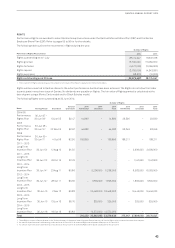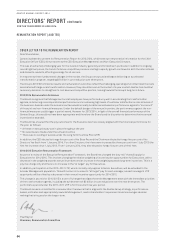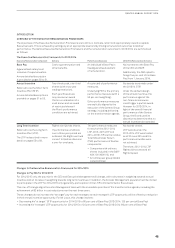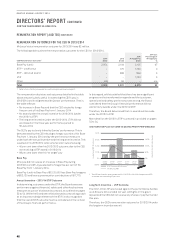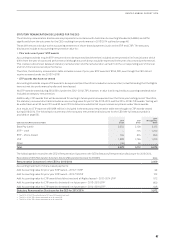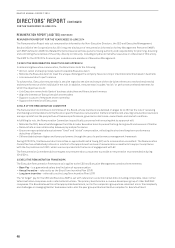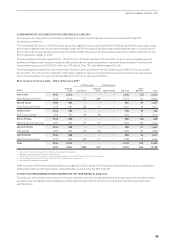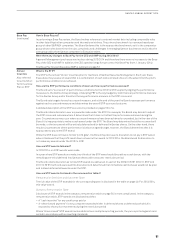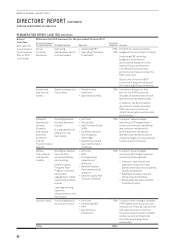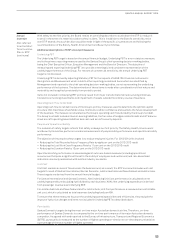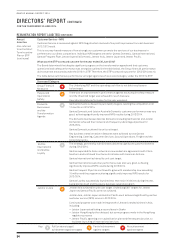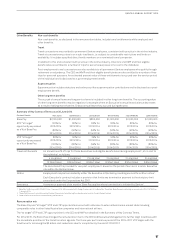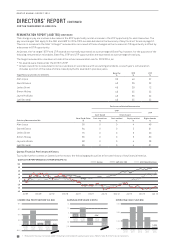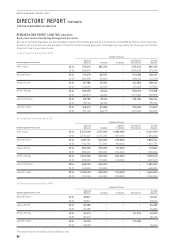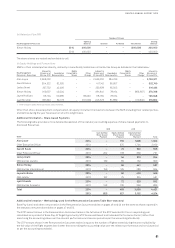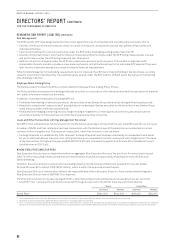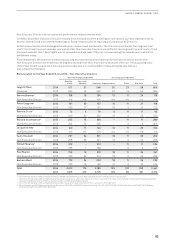Qantas 2014 Annual Report Download - page 55
Download and view the complete annual report
Please find page 55 of the 2014 Qantas annual report below. You can navigate through the pages in the report by either clicking on the pages listed below, or by using the keyword search tool below to find specific information within the annual report.
53
QANTAS ANNUAL REPORT 2014
Annual
Incentive
Also referred
to as the Short
Term Incentive
Plan or STIP
(continued)
With safety as the first priority, the Board retains an overriding discretion to scale down the STIP (or reduce it
to zero) in the event of a material aviation safety incident. This is in addition to the Board’s overall discretion
over STIP awards. Any such decision would be made in light of the specific circumstances and following the
recommendation of the Safety, Health, Environment and Security Committee.
Additional descriptions of STIP scorecard measures
Underlying PBT
The Underlying PBT target is based on the annual financial budget. Underlying PBT is a non-statutory measure,
and is the primary reporting measure used by the Qantas Group’s chief operating decision-making bodies,
being the Chief Executive Officer, Executive Management and the Board of Directors. The objective of
measuring and reporting Underlying PBT is to provide a meaningful and consistent representation of the
underlying performance of the Group. For reasons of commercial sensitivity, the annual Underlying PBT
target is not disclosed.
Underlying PBT is derived by adjusting Statutory PBT for the impacts of AASB 139
Financial Instruments:
Recognition and Measurement
which relate to other reporting periods and items which are identified by
Management and reported to the chief operating decision-making bodies, as not representing the underlying
performance of the business. The determination of these items is made after consideration of their nature and
materiality and is applied consistently from period to period.
Items not included in Underlying PBT primarily result from major transformational/restructuring initiatives,
transactions involving investments and impairment of assets outside the ordinary course of business.
Operating Cash Flow to Net Debt
Operating cash flow to net debt is one of the Group’s primary measures used to determine the optimal capital
structure that maximises shareholder value, maintains creditor confidence and sustains the future development
of the business. The measure is calculated as the Group’s operating cash flow divided by the Group’s net debt.
The Group’s net debt includes interest-bearing liabilities, the fair value of hedges related to debt and off balance
sheet aircraft operating lease liabilities less cash and aircraft security deposits.
People and Operational Safety
The inclusion of safety targets reflects that safety is always our first priority. The Safety, Health, Environment
and Security Committee performs a combined assessment of people safety performance and operational safety
performance.
The objective of the people safety targets is to reduce employee injuries. For 2013/2014 this involved:
–Reducing the Total Recorded Injury Frequency Rate by eight per cent on the 2012/2013 result
–Reducing the Lost Work Case Frequency Rate by 11 per cent on the 2012/2013 result
–Reducing the Duration Rate by 13 per cent on the 2012/2013 result
Operational safety performance is assessed against outcome-based measures (including operational
occurrences that pose a significant threat to the safety of employees and customers) and risk-based lead
indicators commonly associated with aviation industry accidents.
Unit Cost
Unit Cost remains an area of focus across the business and, as a result, the STIP scorecard includes unit cost
targets for each of Qantas International, Qantas Domestic, Jetstar Australia and New Zealand and Jetstar Asia.
These targets are derived from the annual financial budget.
For Qantas International and Qantas Domestic, Net Underlying Unit Cost performance is calculated as net
underlying expenditure (excluding fuel) divided by each business’ ASKs. Net underlying expenditure is derived
from passenger revenue less Underlying EBIT.
For Jetstar Australia and New Zealand and for Jetstar Asia, Unit Cost performance is measured as controllable
unit cost, which is calculated as total expenses (excluding fuel) per ASK.
To ensure that these measures focus on the underlying operating activities and efficiencies, they exclude the
impact of fuel price changes and items not included in Underlying PBT as described above.
Punctuality
Qantas Domestic targets being the most on-time major Australian domestic airline. Therefore, on-time
performance of Qantas Domestic is compared to the on-time performance of its major Australian domestic
competitor. As agreed with and reported to the Bureau of Infrastructure, Transport and Regional Economics
(BITRE), punctuality is measured as the number of flights operating on-time (on an on-time departure basis) as
apercentage of the total number of flights operated.


